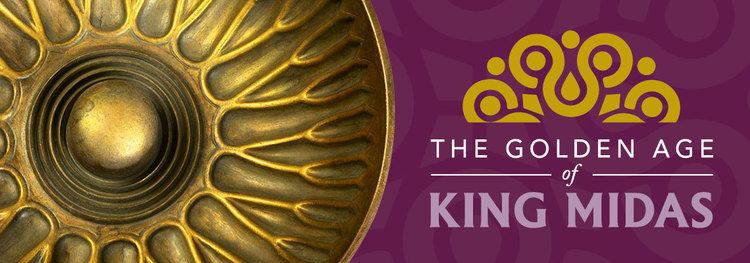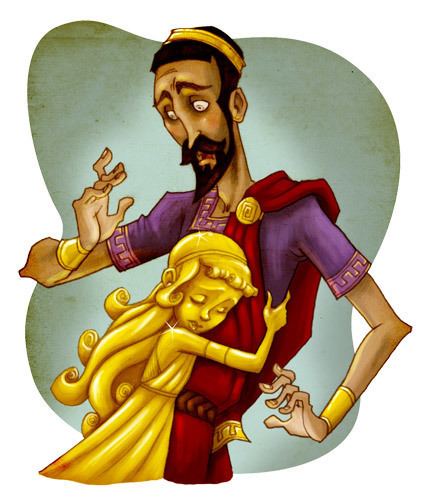 | ||
Similar Orpheus, Medusa, Icarus, Perseus, Minotaur | ||
King midas and the golden touch subtitles
Midas (/ˈmaɪdəs/; Greek: Μίδας) is the name of at least three members of the royal house of Phrygia.
Contents
- King midas and the golden touch subtitles
- Jace midas ft robb banks official video
- Legends
- Golden Touch
- Ears of a Donkey
- Similar myths in other cultures
- Historicity
- Possible tomb
- References
The most famous King Midas is popularly remembered in Greek mythology for his ability to turn everything he touched into gold. This came to be called the golden touch, or the Midas touch. The Phrygian city Midaeum was presumably named after this Midas, and this is probably also the Midas that according to Pausanias founded Ancyra. According to Aristotle, legend held that Midas died of starvation as a result of his "vain prayer" for the gold touch. The legends told about this Midas and his father Gordias, credited with founding the Phrygian capital city Gordium and tying the Gordian Knot, indicate that they were believed to have lived sometime in the 2nd millennium BC, well before the Trojan War. However, Homer does not mention Midas or Gordias, while instead mentioning two other Phrygian kings, Mygdon and Otreus.
Another King Midas ruled Phrygia in the late 8th century BC, up until the sacking of Gordium by the Cimmerians, when he is said to have committed suicide. Most historians believe this Midas is the same person as the Mita, called king of the Mushki in Assyrian texts, who warred with Assyria and its Anatolian provinces during the same period.

A third Midas is said by Herodotus to have been a member of the royal house of Phrygia and the grandfather of an Adrastus who fled Phrygia after accidentally killing his brother and took asylum in Lydia during the reign of Croesus. Phrygia was by that time a Lydian subject. Herodotus says that Croesus regarded the Phrygian royal house as "friends" but does not mention whether the Phrygian royal house still ruled as (vassal) kings of Phrygia.

Jace midas ft robb banks official video
Legends

There are many, and often contradictory, legends about the most ancient King Midas. In one, Midas was king of Pessinus, a city of Phrygia, who as a child was adopted by King Gordias and Cybele, the goddess whose consort he was, and who (by some accounts) was the goddess-mother of Midas himself. Some accounts place the youth of Midas in Macedonian Bermion (See Bryges) In Thracian Mygdonia, Herodotus referred to a wild rose garden at the foot of Mount Bermion as "the garden of Midas son of Gordias, where roses grow of themselves, each bearing sixty blossoms and of surpassing fragrance". Herodotus says elsewhere that Phrygians anciently lived in Europe where they were known as Bryges, and the existence of the garden implies that Herodotus believed that Midas lived prior to a Phrygian migration to Anatolia.

According to some accounts, Midas had a son, Lityerses, the demonic reaper of men, but in some variations of the myth he instead had a daughter, Zoë or "life". According to other accounts he had a son Anchurus.
Arrian gives an alternative story of the descent and life of Midas. According to him, Midas was the son of Gordios, a poor peasant, and a Telmissian maiden of the prophetic race. When Midas grew up to be a handsome and valiant man, the Phrygians were harassed by civil discord, and consulting the oracle, they were told that a wagon would bring them a king, who would put an end to their discord. While they were still deliberating, Midas arrived with his father and mother, and stopped near the assembly, wagon and all. They, comparing the oracular response with this occurrence, decided that this was the person whom the god told them the wagon would bring. They therefore appointed Midas king and he, putting an end to their discord, dedicated his father’s wagon in the citadel as a thank-offering to Zeus the king. In addition to this the following saying was current concerning the wagon, that whosoever could loosen the cord of the yoke of this wagon, was destined to gain the rule of Asia. This someone was to be Alexander the Great. In other versions of the legend, it was Midas' father Gordias who arrived humbly in the cart and made the Gordian Knot.
Herodotus said that a "Midas son of Gordias" made an offering to the Oracle of Delphi of a royal throne "from which he made judgments" that were "well worth seeing", and that this Midas was the only foreigner to make an offering to Delphi before Gyges of Lydia. The historical Midas of the 8th century BC and Gyges are believed to have been contemporaries, so it seems most likely that Herodotus believed that the throne was donated by the earlier, legendary King Midas. However, some historians believe that this throne was donated by the later, historical King Midas.
Golden Touch
One day, as Ovid relates in Metamorphoses XI, Dionysus found that his old schoolmaster and foster father, the satyr Silenus, was missing. The old satyr had been drinking wine and wandered away drunk, to be found by some Phrygian peasants who carried him to their king, Midas (alternatively, Silenus passed out in Midas' rose garden). Midas recognized him and treated him hospitably, entertaining him for ten days and nights with politeness, while Silenus delighted Midas and his friends with stories and songs. On the eleventh day, he brought Silenus back to Dionysus in Lydia. Dionysus offered Midas his choice of whatever reward he wished for. Midas asked that whatever he might touch should be changed into gold.
Midas rejoiced in his new power, which he hastened to put to the test. He touched an oak twig and a stone; both turned to gold. Overjoyed, as soon as he got home, he touched every rose in the rose garden, and all became gold. He ordered the servants to set a feast on the table. "So Midas, king of Lydia, swelled at first with pride when he found he could transform everything he touched to gold; but when he beheld his food grow rigid and his drink harden into golden ice then he understood that this gift was a bane and in his loathing for gold, cursed his prayer" (Claudian, In Rufinem). In a version told by Nathaniel Hawthorne in A Wonder-Book for Girls and Boys (1852), Midas' daughter came to him, upset about the roses that had lost their fragrance and become hard, and when he reached out to comfort her, found that when he touched his daughter, she turned to gold as well. Now, Midas hated the gift he had coveted. He prayed to Dionysus, begging to be delivered from starvation. Dionysus heard his prayer, and consented; telling Midas to wash in the river Pactolus. Then, whatever he put into the water would be reversed of the touch.
Midas did so, and when he touched the waters, the power flowed into the river, and the river sands turned into gold. This explained why the river Pactolus was so rich in gold, and the wealth of the dynasty claiming Midas as its forefather no doubt the impetus for this aetiological myth. Gold was perhaps not the only metallic source of Midas' riches: "King Midas, a Phrygian, son of Cybele, first discovered black and white lead".
Ears of a Donkey
Midas, now hating wealth and splendor, moved to the country and became a worshipper of Pan, the god of the fields and satyr. Roman mythographers asserted that his tutor in music was Orpheus.
Once, Pan had the audacity to compare his music with that of Apollo, and challenged Apollo to a trial of skill (also see Marsyas). Tmolus, the mountain-god, was chosen as umpire. Pan blew on his pipes and, with his rustic melody, gave great satisfaction to himself and his faithful follower, Midas, who happened to be present. Then Apollo struck the strings of his lyre. Tmolus at once awarded the victory to Apollo, and all but one agreed with the judgment. Midas dissented, and questioned the justice of the award. Apollo would not suffer such a depraved pair of ears any longer, and said "Must have ears of an ass!", which caused Midas's ears to become those of a donkey. The myth is illustrated by two paintings, "Apollo and Marsyas" by Palma il Giovane (1544–1628), one depicting the scene before, and one after, the punishment. Midas was mortified at this mishap. He attempted to hide his misfortune under an ample turban or headdress, but his barber of course knew the secret, so was told not to mention it. However, the barber could not keep the secret; he went out into the meadow, dug a hole in the ground, whispered the story into it, then covered the hole up. A thick bed of reeds later sprang up in the meadow, and began whispering the story, saying "King Midas has an ass' ears". Some sources said that Midas killed himself by drinking the blood of an ox.
Sarah Morris demonstrated (Morris 2004) that donkeys' ears were a Bronze Age royal attribute, borne by King Tarkasnawa (Greek Tarkondemos) of Mira, on a seal inscribed in both Hittite cuneiform and Luwian hieroglyphs: in this connection, the myth would appear for Greeks to justify the exotic attribute.
Similar myths in other cultures
In pre-Islamic legend of Central Asia, the king of the Ossounes of the Yenisei basin had donkey's ears. He would hide them, and order each of his barbers murdered to hide his secret. The last barber among his people was counselled to whisper the heavy secret into a well after sundown, but he didn't cover the well afterwards. The well water rose and flooded the kingdom, creating the waters of Lake Issyk-Kul.
According to an Irish legend, the king Labraid Loingsech had horse's ears, something he was concerned to keep quiet. He had his hair cut once a year, and the barber, who was chosen by lot, was immediately put to death. A widow, hearing that her only son had been chosen to cut the king's hair, begged the king not to kill him, and he agreed, so long as the barber kept his secret. The burden of the secret was so heavy that the barber fell ill. A druid advised him to go to a crossroads and tell his secret to the first tree he came to, and he would be relieved of his burden and be well again. He told the secret to a large willow. Soon after this, however, a harper named Craiftine broke his instrument, and made a new one out of the very willow the barber had told his secret to. Whenever he played it, the harp sang "Labraid Lorc has horse's ears". Labraid repented of all the barbers he had put to death and admitted his secret.
Historicity
The King Midas who ruled Phrygia in the late 8th century BC is known from Greek and Assyrian sources. According to the former, he married a Greek princess, Damodice daughter of Agamemnon of Cyme, and traded extensively with the Greeks. Some historians believe this Midas donated the throne that Herodotus says was offered to the Oracle of Delphi by "Midas son of Gordias" (see above). Assyrian tablets from the reign of Sargon II record attacks by a "Mita", king of the Mushki, against Assyria's eastern Anatolian provinces. Some historians believe Assyrian texts called this Midas king of the "Mushki" because he had subjected the eastern Anatolian people of that name and incorporated them into his army. Greek sources including Strabo say that Midas committed suicide by drinking bulls' blood during an attack by the Cimmerians, which Eusebius dated to around 695 BC and Julius Africanus to around 676 BC. Archeology has confirmed that Gordium was destroyed and burned around that time.
Possible tomb
In 1957, Rodney Young and a team from the University of Pennsylvania opened a chamber tomb at the heart of the Great Tumulus (in Greek, Μεγάλη Τούμπα)—53 metres in height, about 300 metres in diameter—on the site of ancient Gordion (modern Yassihöyük, Turkey), where there are more than 100 tumuli of different sizes and from different periods. They discovered a royal burial, its timbers recently dated as cut to about 740 BC complete with remains of the funeral feast and "the best collection of Iron Age drinking vessels ever uncovered". This inner chamber was rather large: 5.15 metres by 6.2 metres in breadth and 3.25 metres high. On the remains of a wooden coffin in the northwest corner of the tomb lay a skeleton of a man 1.59 metres in height and about 60 years old. In the tomb were found an ornate inlaid table, two inlaid serving stands, and eight other tables (Gordion Furniture and Wooden Artifacts), as well as bronze and pottery vessels and bronze fibulae. Although no identifying texts were originally associated with the site, it was called Tumulus MM (for "Midas Mound") by the excavator. As this funerary monument was erected before the traditional date given for the death of King Midas in the early 7th century BC, it is now generally thought to have covered the burial of his father.
